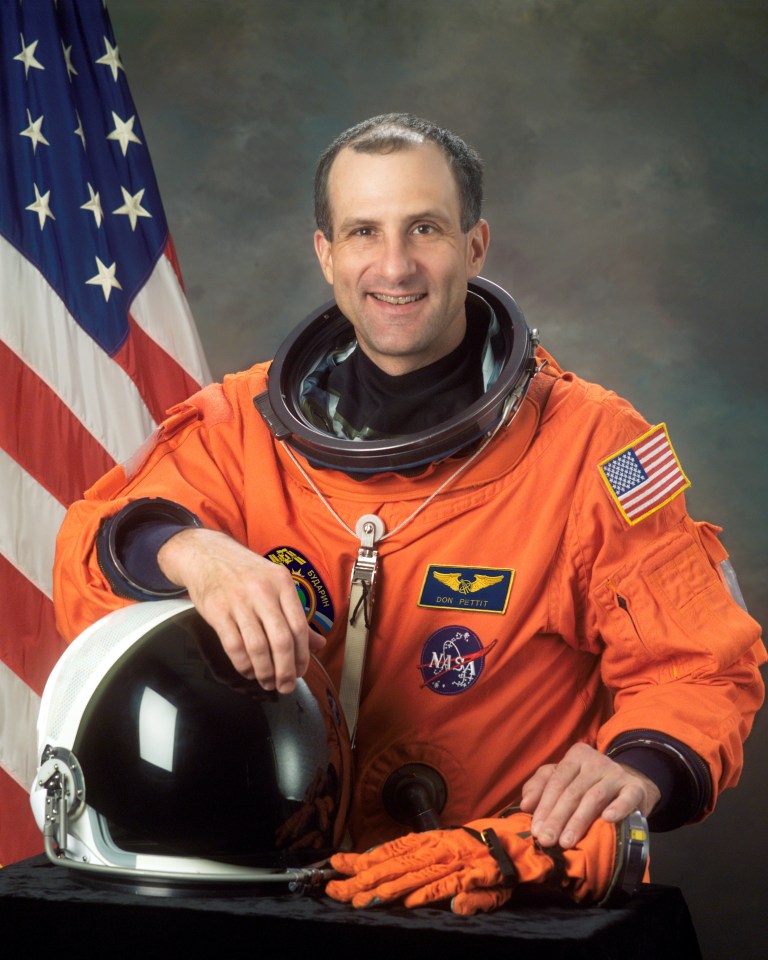
Donald R. Pettit
NASA Astronaut
Follow Donald
Summary
Donald R. Pettit (Ph.D.) was selected by NASA in 1996. The Silverton, Oregon native holds a Bachelor of Science in Chemical Engineering from Oregon State University and a Doctorate in Chemical Engineering from the University of Arizona. Prior to becoming an astronaut, he worked as a staff scientist at the Los Alamos National Laboratory, New Mexico. A veteran of three spaceflights, Pettit served as NASA Science Officer for Expedition 6 in 2003, operated the robotic arm for STS-126 in 2008 and served as a Flight Engineer for Expedition 30/31 in 2012, where he lived aboard the International Space Station for more than one year. Pettit launched to the International Space Station aboard the Roscosmos Soyuz MS-26 spacecraft September 11, 2024, accompanied by Roscosmos cosmonauts Alexey Ovchinin and Ivan Vagner. Pettit is currently serving as a flight engineer and member of the Expedition 72 crew aboard the orbiting laboratory, where he will spend approximately 6 months conducting science experiments and maintaining the space station.
Experience
Staff scientist at Los Alamos National Laboratory, Los Alamos, New Mexico from 1984 to 1996. Projects included reduced gravity fluid flow and materials processing experiments onboard the NASA KC-135 airplane, atmospheric spectroscopy on noctilucent clouds seeded from sounding rockets, fumarole gas sampling from volcanoes and problems in detonation physics. He was a member of the Synthesis Group, a presidential commission lead by Lt. Gen. (Ret.) Tom Stafford tasked with assembling the technology to return to the Moon and explore Mars (1990) and the Space Station Freedom Redesign Team (1993).
NASA Experience
Selected by NASA to be an astronaut in April 1996, Dr. Pettit reported to the Johnson Space Center in August 1996. A veteran of three spaceflights, Dr. Pettit has logged more than 370 days in space and over 13 spacewalk hours. He lived aboard the International Space Station for 5 1/2 months during Expedition 6, was a member of the STS-126 crew, and again lived aboard the station for 6 1/2 months as part of the Expedition 30/31 crew.
Pettit launched to the International Space Station aboard the Roscosmos Soyuz MS-26 spacecraft September 11, 2024, accompanied by Roscosmos cosmonauts Alexey Ovchinin and Ivan Vagner. Pettit is currently serving as a flight engineer and member of the Expedition 72 crew aboard the orbiting laboratory, where he will spend approximately 6 months conducting science experiments and maintaining the space station.
Spaceflight Experience
Expedition 6 (November 23, 2002 to May 3, 2003). Dr. Pettit completed his first spaceflight as NASA Science Officer aboard the International Space Station with Mission Commander Ken Bowersox, and Flight Engineer Nikolai Budarin, logging more than 161 days in space. During their mission, the crew performed science experiments while continuing space station construction. Dr. Pettit and Ken Bowersox performed two spacewalks. The Expedition 6 crew launched on STS-113 Space Shuttle Endeavour expecting to return on STS-114 Space Shuttle Discovery after a 2 1/2-month mission. Following the Columbia Space Shuttle disaster that grounded the Space Shuttle fleet, they returned to Earth after 5 1/2 months on Soyuz TMA-1, landing in Kazakhstan with a malfunction-caused ballistic entry. This off-nominal entry resulted in the landing 475 kilometers off course and taking about half a day before recovered by ground rescue teams.
STS-126 (November 14 to November 30, 2008). The Space Shuttle Endeavour launched from the Kennedy Space Center, Florida, and due to bad weather, returned to land at Edwards Air Force Base, California. The 16-day mission included expanding the living quarters of the International Space Station and a regenerative life support system that reclaims potable water from urine. During the mission, Dr. Pettit operated the robotic arm for four spacewalks.
Expedition 30/31 (December 21, 2011 to July 1, 2012). Pettit launched to the International Space Station aboard the Soyuz TMA-03M spacecraft from Kazakhstan. Don Pettit, Russian Soyuz Commander Oleg Kononenko and European Space Agency Flight Engineer Andre Kuipers of the Netherlands docked to the station on December 23, 2011. Dr. Pettit did scientific research, repair of ISS systems, and captured the first commercial cargo spacecraft, the SpaceX Dragon D1 using the robotic arm. They landed in Kazakhstan after 193 days in space.
Pronunciation
DON-uld PED-it


























